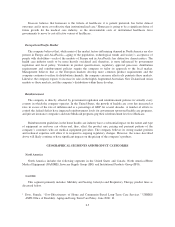Invacare 2011 Annual Report Download - page 21
Download and view the complete annual report
Please find page 21 of the 2011 Invacare annual report below. You can navigate through the pages in the report by either clicking on the pages listed below, or by using the keyword search tool below to find specific information within the annual report.The 2010 health care reform law in the U.S., the Patient Protection and Affordable Care Act, included a
number of provisions affecting the HME industry. First, the health care law expanded Round 2 of the Medicare
National Competitive Bidding program from 70 to 91 geographic bid areas. Round 2 is currently scheduled to go
into effect July 2013. Second, Medicare now makes rental payments for 13 months before the beneficiary
assumes ownership of the standard power wheelchair. Finally, the new health care law imposed a “productivity
adjustment” to the annual fee schedules of all Medicare providers, including HME providers, that limits any
annual cost of living increases applied to the fee schedules. The 2010 health care reform law also includes a new
tax on U.S. sales of medical device manufacturers or importers, such as Invacare. The law will impose a yearly
2.3% sales-based excise tax on medical device manufacturers starting in 2013. The excise tax will be deductible
by the manufacturer on its federal income tax return. The excise tax will not apply to medical devices that the
Secretary of Treasury determines are generally purchased by the general public at retail for individual use. In
January 2012, the Department of the Treasury issued guidance on the definition of a taxable medical device
related to the excise tax. While the company believes a portion of its products will be exempt from the excise tax
under the retail exemption, it is still in the process of fully analyzing the implications of the excise tax by the
Department of the Treasury. The company intends to respond to the IRS and the Treasury Department to seek
additional clarity on the proposed regulations.
Although reductions in Medicare payments are not beneficial to the homecare industry, the company
believes it can still grow and thrive in this environment. No significant cost-of-living adjustments have been
made over the last few years to the reimbursement and payment amounts permitted under Medicare with respect
to the company’s products, but the company will continue to try to respond with improved productivity. In
addition, the company’s respiratory therapy products (for example, the low-cost HomeFill®oxygen delivery
system) can help offset the Medicare reimbursement cuts to the homecare provider. The company will continue
to focus on developing products that help the provider improve profitability. Additionally, the company
continues to focus on low-cost country sourcing and/or manufacturing to help ensure that the company is one of
the lowest cost manufacturers and distributors to the homecare provider.
BACKLOG
The company generally manufactures most of its products to meet near-term demands by shipping from
stock or by building to order based on the specialty nature of certain products. Therefore, the company does not
have substantial backlog of orders of any particular product nor does it believe that backlog is a significant factor
for its business.
EMPLOYEES
As of December 31, 2011, the company had approximately 6,200 employees.
FOREIGN OPERATIONS AND EXPORT SALES
The company also markets its products for export to other foreign countries. In 2011, the company had
product sales in over 80 countries worldwide. For information relating to net sales, operating income and
identifiable assets of the company’s foreign operations, see Business Segments in the Notes to the Consolidated
Financial Statements.
I-15
























